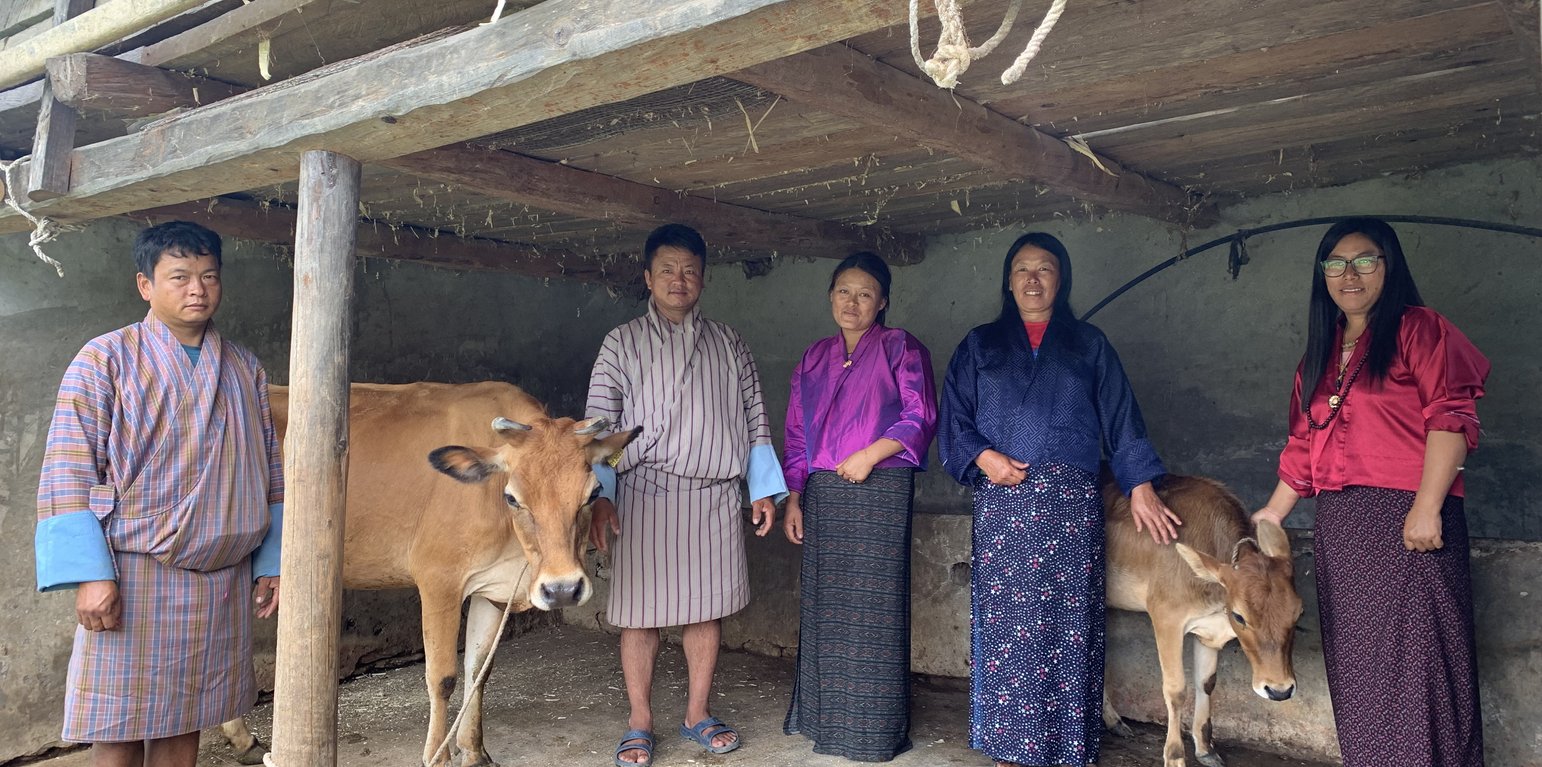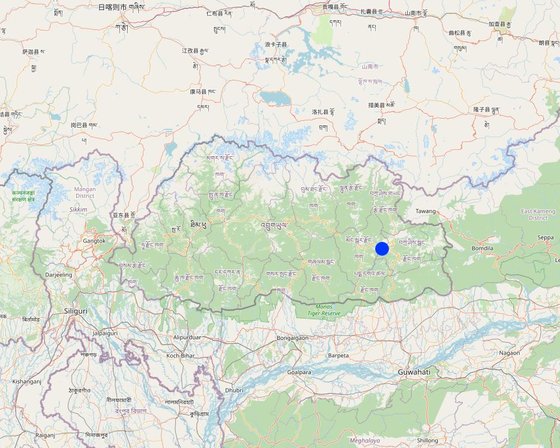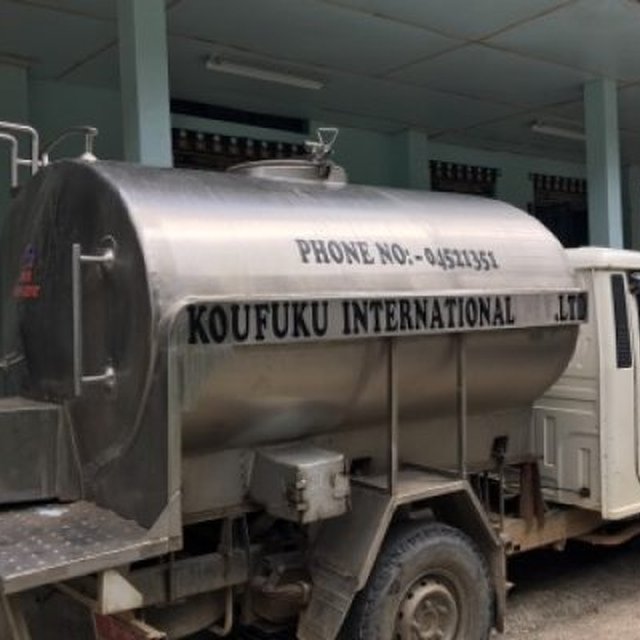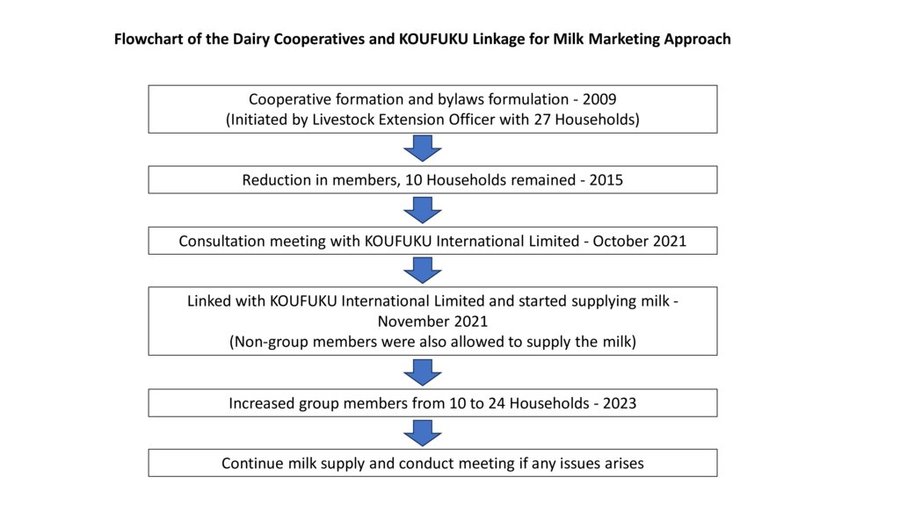



This approach links dairy cooperatives with a dairy plant, KOUFUKU International Limited (KIL), for milk marketing. It is an established dairy value chain that addresses milk and dairy product marketing issues and improves the livelihoods of many small dairy farmers in eastern Bhutan. The approach encompasses milk cooperatives, collection centres, milk transport vans, and the processing unit operated by KIL. Currently, milk is supplied to the company by approximately 22 milk cooperatives, each consisting of land users engaged in dairy farming. This documentation focuses on the linkage between KIL and one such cooperative named Samphel Chirphen Jersey Detshen of Udzorong Gewog in Trashigang Dzongkhag.
At the heart of the system are collection centres, strategically placed at each dairy cooperative and equipped with chilling machines. Managed by the dairy cooperatives, these centres serve as crucial points for milk collection. A dedicated milk transport van and driver is arranged to facilitate the transportation of milk from individual land users to the collection point, and onward to the processing unit. Designed with insulation, the van ensures the quality of the milk is maintained, preventing deterioration during transit. The pricing structure for land users is influenced by their choice in milk collection and transport: those opting for the company's services receive a lower price per litre.
The KIL processing unit, situated in Chenary, Trashigang Dzongkhag, is a subsidiary of Druk Holding and Investments Limited (DHI). This unit produces a variety of processed milk products, including "Druk Zambala Cheese," salted and non-salted butter, stirred yogurt, gouda cheese, and cottage cheese. This approach improves the livelihoods of land users, encouraging cooperative members to increase milk production which ultimately increases cash income.
For KIL, the company's involvement aims to augment processing capacity. Despite having the potential to process 4000 litres of milk daily, only 44% of this capacity was utilized as of 2021. The approach embraces an inclusive model, involving smallholder land users in cooperative formation and connecting them to the market, making it a successful value chain intervention.
The implementation method of Samphel Chirphen Jersey Detshen employs a consultative approach, engaging various stakeholders such as the Gewog Livestock Extension Officer, Dzongkhag Livestock Officer, CARLEP officials, and a representative from KIL. This collaborative method enables land users to voice their needs, ensuring decisions that benefit the community.
The stages of implementation involve the initiation of cooperative formation driven by awareness created by the Livestock Extension Officer. Group formation facilitates resource-sharing and reduces workload of land user. Further, subsidies and incentives support from the government are directed towards the cooperative rather than individual land users, emphasizing the importance of forming cooperatives to maximize benefits. The dairy cooperative members were supported to construct improved cattle sheds and biogas plants to improved livestock rearing.
Initially, the Samphel Chirphen Jersey Detshen faced marketing challenges, prompting government intervention to connect them with KIL. Consultations resulted in an agreement where land users committed to supplying a minimum of 100 litres per day at a negotiated rate of Nu. 35 per litre, establishing KIL as their end market. Subsequently, improved cattle breeds were acquired, and the cooperatives increased their daily milk supply from 71 to 280-300 litres. Stakeholders, including Gewog Livestock Extension Officer, Dzongkhag Livestock Officer, Gewog Officials, and CARLEP-IFAD, play pivotal roles in providing technical guidance, subsidies, and funding. Regular monitoring ensures the success of the activity.
In summary, this approach benefits land users by enhancing marketing services and providing sustainable sources of household income – and indirectly improves SLM through encouraging better husbandry of dairy cattle and associated biogas plants.

ສະຖານທີ່: Tshedung Village, Rizor Chiwog, Udzorong Gewog, Trashigang Dzongkhag, ບູຕານ
ວັນທີເລີ່ມຕົ້ນ: 2021
ປີຂອງການສິ້ນສຸດ: n.a.
ປະເພດຂອງແນວທາງ
| ແມ່ນໃຜ / ພາກສ່ວນໃດ ທີ່ເປັນເຈົ້າການ ໃນການຈັດຕັ້ງປະຕິບັດ ວິທີການ? | ລະບຸ ພາກສ່ວນທີ່ກ່ຽວຂ້ອງ | ພັນລະນາ ບົດບາດ ໜ້າທີ່ ຂອງພາກສ່ວນທີ່ກ່ຽວຂ້ອງ |
| ຜູ້ນໍາໃຊ້ດິນໃນທ້ອງຖິ່ນ / ຊຸມຊົນທ້ອງຖິ່ນ | A total of 34 members (25 male and 9 female), aged between 35 to 50 years old from Samphel Chirphen Jersey Detshen were involved in the approach. | Produce and supply fresh milk to milk processing unit. Elected members such as Chairman, Secretary and Treasures to function as per bylaws. |
| ຜູ້ຊ່ຽວຊານ ການນຄຸ້ມຄອງ ທີ່ດິນແບບຍືນຍົງ / ທີ່ປຶກສາດ້ານກະສິກໍາ | Gewog Livestock Officer and Dzongkhag Livestock Officer | Provide technical inputs, monitor the activities and progress of the group and take issues that are not resolved within the cooperative to higher forums such as Gewog and Dzongkhag meetings. |
| ພາກເອກະຊົນ | KOUFUKO International Limited | Purchase milk from the land users and provide support in transportation and marketing. |
| ອໍານາດ ການປົກຄອງທ້ອງຖິ່ນ | Gup, Tshokpa, Mangmi | Monitor group activities and allocate gewog funds if required for the group. For example, the Gewog fund of Nu. 10,00,000/- (Ten hundred thousand) was allocated to purchase improved cattle breeds (jersey) for the land users where a 70% subsidy was provided and only 30% of the total cost was borne by land users. |
The flowchart is developed in consultation with the land users.

ການຕັດສິນໃຈໂດຍ
ການຕັດສິນໃຈບົນພື້ນຖານ
Cattle shed and biogas plant construction and their benefits. Fodder grass plantations such as napier, super napier (Pakchong), and others.
Donor funded 100% for the milk collection can, butter churner, and chiller machine.
70% by the donor CARLEP and 30% by the land user
Fodder seeds were fully financed
100% financed for the construction of biogas and cattle shed
18 bags of cement, 18 CGI sheet, half truck sand.
ແຮງງານຂອງຜູ້ນໍ້າໃຊ້ທີ່ດິນ
The approach improved farm income, knowledge and skills empowering land users to deal with difficult situations efficiently.
Yes, to cite an example, the land users learned that super napier (Napier Pakchong 1 which is a hybrid between Pennisetum purpureum and Pennisetum americanum cv. Pakchong 1) gives more milk than the guatemala. Therefore, they opted for plantation of super napier than guatemala.
Yes, the approach improves market linkage and indirectly encourages land users to increase milk production due to an assured market. The byproduct of the approach (cow dung) can be used to develop farm yard manure (FYM) and biogas plants ultimately improving soil quality, production of alternative energy source for cooking and heating.
The approach enabled stakeholders to mobilize funds and provide subsidies and financial resources to implement SLM. The land users got Nu. 20000/- loan from BDBL to construct improved diary shed.
Through the approach, the land users were trained on SLM implementation increasing their knowledge and skills.
The cooperative is supported by various stakeholders in terms of technical and advisory services. When there is any issues faced by the land users, they turn to the stakeholders for support, where the stakeholders need to develop a method to solve their issues leading to improved knowledge of the stakeholders.
The approach improved collaboration between stakeholders including CARLEP-IFAD, Gewog and Dzongkhag officials and KOUFUKU International Limited company.
In the past, there were social conflicts in the group as there were a few individuals who failed to do their duty of collecting milk and turning up for other group activities leading to social conflict and misunderstanding. With the establishment of linkage with the processing unit, marketing is facilitated by the company leading to a significant reduction in the social conflict.
Any interested land users irrespective of their gender can be part of the cooperative. The greater number of males in the group member list is due to the majority of the men being head of the household. While implementing, both the parties are given equal opportunity.
Although there are opportunities for the youths to open a large-scale dairy farm with a secured market. There were no interested youth from the community to take up dairy farming. This could be due to better opportunities and facilities available in the town than village setting. However, there were few youth entrepreneurs from the Dzongkhag involved in large-scale dairy farming.
The approach provided a sustainable income source increasing the land users' buying capacity for nutritious foods.
There is a significant improvement in the milk market as the buyer comes to the land users' doorstep to collect milk.
Yes, the approach led to the implementation of biogas technology which is one of the sustainable sources of energy.
On average individual household generates Nu. 12000/- by selling milk. Thereby, improving farm income and motivating land users to engage in livestock farming ultimately generating employment.
Support needed for the establishment of the linkage is completed. Hereafter, the land users can sustain themselves without external support.